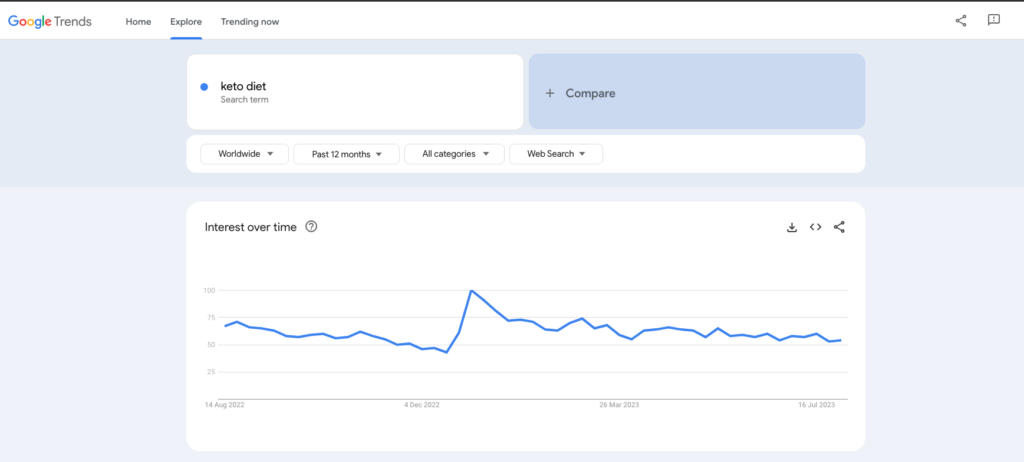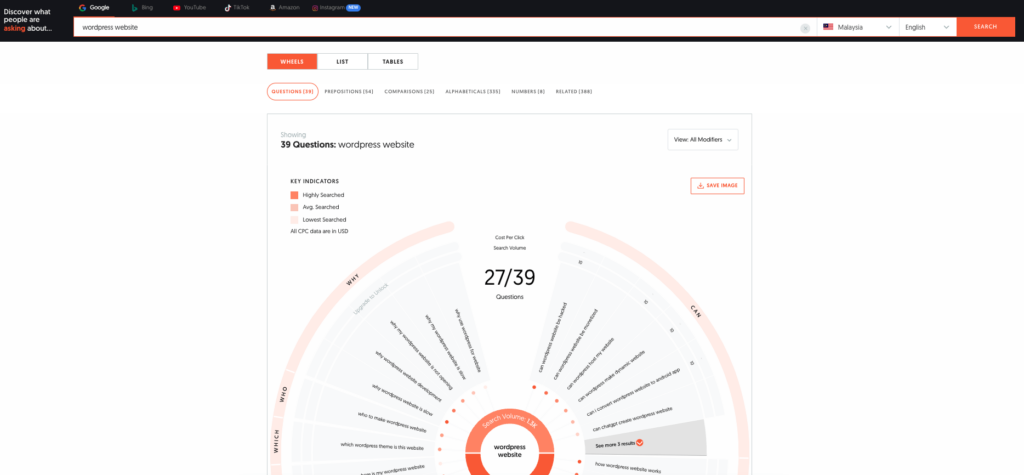Imagine you’re craving spaghetti and meatballs. You’d likely type “Italian restaurant near me” into Google, instantly finding options nearby. Just like that, if you want customers to easily find your business—whether it’s a restaurant, consulting service, or online shop—you need to know the keyword they’re using. The right keywords not only improve your SEO but also make your business more visible to potential customers online.
In this guide, we’ll show you how to use a keyword research tool. This will help you find the terms your audience is searching for. You will also learn how to use tools like Google Keyword Planner. These tools can help you generate new keyword ideas to improve your search rankings.
By following these essential SEO steps, you can make your website stand out. You’ll also be able to rank higher in search results and connect with the right audience.
Optimize Your WordPress Website with WordPress Hosting
How to Boost SEO with Keyword Research

In today’s digital landscape, search engine optimization (SEO) is essential to ensure your website ranks well and reaches your target audience. Here’s a comprehensive guide on the foundational steps to kickstart your SEO strategy and connect with the right audience effectively.
1. Utilize Keyword Research Tools to Discover Targeted Keywords
Keyword research is the backbone of any successful SEO strategy. To effectively attract your audience, it is essential to identify keywords that align with their search queries and interests. Fortunately, keyword research tools like Google’s Keyword Planner (available with a Google Ads account), as well as other powerful options such as Ahrefs, SEMrush, and Ubersuggest, enable you to achieve this.
Firstly, these tools help you uncover relevant keywords. By finding keywords related to your industry or niche, you can ensure that they match your audience’s search intent. In addition to this, you can analyze search volume and competition, allowing you to prioritize keywords that have a high search volume and manageable competition. This strategic focus helps maximize your reach.
Moreover, keyword research tools assist in identifying trends and user intent. By spotting trending keywords, you can recognize terms that indicate whether users are looking for information, making comparisons, or ready to make a purchase. Therefore, by consistently utilizing these tools, you can optimize your content to rank for the most relevant and valuable keywords. Ultimately, this approach makes it easier to reach your target audience effectively.
2. Create High-Quality, Intented Content
Once you’ve identified relevant keywords, the next step is to create high-quality, engaging content that addresses your audience’s needs. It is important to recognize that Google’s algorithm prioritizes content that provides real value, making it critical to focus on several key aspects.
Firstly, you should match search intent. Different keywords signal different user intents, which can be informational, navigational, commercial, or transactional. For example, users searching for “best SEO tools” might be comparing options, while those searching for “buy SEO tool subscription” are likely ready to make a purchase. Understanding this distinction allows you to tailor your content accordingly.
Additionally, adding value through expertise is essential. Your content should go beyond providing basic information; instead, offer expert insights, actionable advice, and updated data where applicable. This approach not only enhances the usefulness of your content but also establishes your authority in the field.
Moreover, enhancing user engagement is crucial for retaining reader interest. Your content should be well-organized, featuring clear headings, bullet points, and visuals. These elements make it easier for users to read and absorb information.
By producing quality content that aligns with your audience’s intent, you can boost your authority and search rankings. This, in turn, improves both organic SEO and paid campaigns when targeting high-value keywords, ultimately driving better results for your online presence.
3. Optimize Your Site’s Structure and Speed
Your website’s structure and loading speed significantly impact both user experience and SEO performance. Understanding these elements is crucial for optimizing your online presence.
Firstly, fast-loading pages are essential. A website that loads quickly not only enhances user experience but also reduces bounce rates and increases the time users spend on your site. In fact, Google’s algorithm favours fast-loading sites, so it’s advisable to aim for a load time of under three seconds to keep visitors engaged.
Additionally, having an intuitive site architecture plays a vital role. A well-organized structure helps users navigate your site with ease while enabling search engines to index your pages effectively. To achieve this, consider using clear categories, logical URLs, and easy-to-follow navigation to guide visitors through your content seamlessly.
Moreover, mobile optimization cannot be overlooked. Google employs mobile-first indexing, meaning it primarily considers the mobile version of content for ranking purposes. Therefore, ensuring your site is mobile-friendly with a responsive design is essential for reaching a broader audience.
4. Track and Refine Performance with Google Search Console
Tracking your SEO efforts is essential for understanding what strategies are effective and where improvements are needed. One invaluable tool for gaining insights into your website’s performance is Google Search Console.
Firstly, you can monitor search queries to see which search terms lead users to your site. This information helps you focus on the keywords that attract the most traffic, enabling you to optimize your content accordingly.
In addition, analyzing clicks, impressions, and average position provides critical metrics that reveal how visible your site is on search engine results pages (SERPs). These metrics can indicate areas that need enhancement, allowing you to make informed adjustments to your strategy.
Moreover, Google Search Console helps you fix indexing issues by alerting you to any problems related to indexing or crawling. This ensures that your pages remain accessible to search engines, which is vital for maintaining your site’s visibility.
5. Conduct Long-Tail Keyword Research for Targeted Traffic
Long-tail keywords are specific phrases that target niche audiences, often presenting less competition and making them easier to rank for. Although these keywords typically have lower search volumes, they tend to attract users who are closer to making a decision or taking action.
First, targeting niche audiences with long-tail keywords allows you to connect with users who have more specific needs. This specificity increases the likelihood of conversions since these users are often further along in their decision-making process.
Additionally, long-tail keywords help reduce competition. For instance, ranking for a phrase like “how to start a gluten-free baking blog” is significantly easier than competing for a more generic term like “baking blog.” Despite the lower search volume, the targeted nature of the long-tail keyword attracts a highly interested audience.
To effectively leverage long-tail keywords, utilize keyword research tools to identify relevant options. These tools can help you build a comprehensive list of long-tail keywords that align with your niche.
Optimize Your WordPress Website with WordPress Hosting
Step By Step Guide to Perform Keyword Research

Keyword research is an essential component of an effective SEO strategy. It involves finding and analyzing the words or phrases your target audience uses when searching for products, services, or information. By understanding and leveraging these keywords, you can craft your website content to improve your search rankings and reach the right audience. Here’s a detailed, step-by-step guide to help you get started with keyword research.
Step 1: Research Your Niche
The first step in keyword research is to understand your niche or industry. Knowing the landscape helps you uncover relevant keywords and content ideas. Start by exploring:
- Current Trends: Track the latest changes, trends, and popular topics in your industry. This will highlight relevant keywords and help you stay updated with the audience’s interests.
- Audience Profile: Understand your audience’s demographics, preferences, and challenges. Analyzing their profile will help you create content that truly resonates.
- Competitive Landscape: Study your competitors to see which keywords they prioritize and which content types perform well. This can reveal opportunities and gaps.
- Industry Language: Familiarize yourself with industry-specific terms or jargon. These specialized keywords can attract a niche audience.
Step 2: Set Clear Objectives and Goals
Define your objectives and goals for keyword research to keep your efforts focused. Ask yourself:
- What do I want to achieve with SEO?
- Is my goal to increase website traffic, generate leads, or drive sales?
- What metrics will I use to measure success (e.g., organic traffic, conversion rate, or ranking position)?
Setting clear goals helps prioritize keywords that align with your objectives, guiding you to focus on terms that contribute to desired outcomes.
Step 3: Create a List of Relevant Topics
Brainstorm a list of broad topics that align with your business goals. These topics will guide your SEO keyword search and ensure that your content appeals to your target audience.
- Use tools like Google Keyword Planner to explore each topic’s monthly search volume and popularity.
- Avoid keyword stuffing by focusing on related keywords that fit naturally within your content.
For instance, a fitness coach might focus on broad topics such as “nutrition,” “strength training,” and “healthy lifestyle,” which then branch into more specific keyword ideas.
Step 4: Generate a Catalog of Primary Keywords
Once you have broad topics, narrow down to specific primary keywords that capture each topic’s core intent. For this:
- Use Google’s AutoSuggest or keyword planner tools to identify phrases that users commonly search.
- Start with broad terms and refine them based on monthly search volume and relevance to your audience.
These primary keywords serve as the backbone of your content strategy, helping your site rank higher for terms that directly relate to your business.
Step 5: Leverage Keyword Research Tools
Using keyword research tools is essential for building a well-rounded keyword list. They provide insights into user intent, search volume, and competition levels. Here are a few effective tools to consider:
- Google Keyword Planner: A free tool to discover popular keywords, match types, and competition levels. It’s particularly useful for insights on PPC advertising.
- Ahrefs: Known for site audits, rank tracking, and competitor analysis, Ahrefs provides detailed metrics on domain rankings and SERP features.
- SEMrush: This tool combines site optimization, competitor research, and keyword analysis, offering valuable SEO content strategies.
- Moz Keyword Explorer: Moz focuses on SERP features, keyword difficulty, and insights on first-page rankings.
These tools help build a keyword list based on real user data, allowing you to optimize content with precision.
Step 6: Analyze Search Intent
Understanding user search intent is essential for a successful keyword strategy. Generally, search intent can be categorized into four main types:
- Informational Intent: Users are seeking answers or general information (e.g., “How to lose weight”).
- Navigational Intent: Users want to find a specific website or page (e.g., “Facebook login”).
- Transactional Intent: Users are ready to make a purchase or take an action (e.g., “Buy fitness tracker”).
- Commercial Investigation: Users are researching options before purchasing (e.g., “Best fitness apps 2023”).
By tailoring your content to match these intents, you can better meet user expectations and increase engagement.
Step 7: Understand Keyword Intent
Keyword intent is closely related to search intent, and recognizing it helps you select keywords that align with user needs. Keywords are often grouped by intent:
- Navigational Intent: Keywords showing navigational intent are specific to a known destination, such as a brand or website, and don’t often require new content.
- Informational Intent: These keywords suggest that users are seeking knowledge. Content such as blog posts, tutorials, and FAQs are effective here.
- Transactional Intent: Users ready to take action, like making a purchase, will use transactional keywords. Content aimed at this intent includes product pages, landing pages, and CTAs.
Categorizing keywords by intent helps you create targeted content that drives specific actions, leading to better engagement and conversions.
Step 8: Analyze Your Competitors
Evaluating your competitors’ keyword strategy provides insight into valuable keywords and content types they leverage to attract their audience. To gain insights:
- Identify Competitors: Determine which businesses compete for similar keywords.
- Use Competitor Analysis Tools: Tools like SEMrush or Ahrefs can reveal competitors’ keyword data, including monthly search volume and top-performing keywords.
- Find Content Gaps: Look for keywords your competitors rank for that you’re not targeting. This highlights potential areas to improve or expand upon.
- Backlink Analysis: Identify websites linking to your competitors, which can be potential sources for backlinks to boost your site’s authority.
This approach allows you to refine your keyword strategy based on effective keywords and content types in your industry.
Optimize Your WordPress Website with WordPress Hosting
Tools That Helps in Keyword Research
Keyword research is vital to identifying new opportunities and refining your SEO strategy. The right tools can reveal valuable keywords, assess keyword difficulty, and provide insights into search trends. Here’s a list of essential keyword research tools to help elevate your online presence and maximize content visibility:
1. Google Ads Keyword Planner
Google Ads Keyword Planner is a reliable tool for uncovering new keywords. It helps you identify target terms that are relevant to your content. The tool enables you to find keywords with high relevance while providing insights into competition levels and search volume. This information helps you focus on terms that can drive meaningful engagement.
Although Keyword Planner is primarily designed for paid advertising campaigns, it also offers valuable data for enhancing your organic SEO strategy. You can gain insights into how certain keywords perform. This knowledge can guide you in refining both paid and organic search tactics.
Accessing Keyword Planner is simple and cost-effective. While it requires a Google Ads account, there’s no spending requirement. You can use it freely to discover impactful keywords without any financial commitment. This tool is particularly useful for assessing keyword difficulty and competition. It gives you a solid foundation for optimizing your SEO strategy around popular, high-impact terms.
2. Google Trends

Google Trends is an invaluable tool for analyzing keyword popularity and gauging interest over time. It offers insights that can elevate your content strategy.
With trending topics, you can explore popular and emerging keywords across various categories, such as business, health, and technology. This feature helps you stay current with what resonates in your industry, giving you an edge in crafting timely and relevant content.
Google Trends also provides regional interest data. This allows you to compare keyword popularity across different geographic areas. It’s particularly useful if you aim to reach specific local markets or understand regional differences in search behavior.
With real-time data at your fingertips, you can track seasonal trends and keyword growth patterns. This ensures your content remains timely. By understanding search trends and regional preferences, Google Trends empowers you to refine your keyword strategy and develop content that truly connects with your target audience.
3. SEMrush Keyword Research Tool
SEMrush is a widely respected keyword research tool that offers a comprehensive analysis of keyword performance and competitive insights. It can significantly elevate your SEO strategy.
With SEMrush, you gain access to detailed keyword data, including organic performance metrics, related questions, and search intent. This information helps you understand which terms are popular and how users are searching. This insight allows you to create content that aligns with their needs.
The competitor analysis features are equally powerful. SEMrush enables you to uncover your competitors’ high-performing keywords, observe their strategies, and identify content gaps that you can fill. This approach provides a roadmap for creating unique and targeted content that stands out in your niche.
Additionally, SEMrush offers SEO tips and insights derived from actual PPC ads. This gives you inspiration for crafting optimized content based on real-world advertising trends. With its robust analytics, SEMrush is an invaluable tool for building a strategic, data-driven approach to SEO and discovering impactful keywords that drive results.
4. KeywordTool.io
KeywordTool.io is a highly versatile tool that excels in generating long-tail keywords and uncovering user-friendly variations, making it a valuable asset for targeted SEO efforts.
One of its standout features is the ability to produce over 750 keyword suggestions for each search term. This capability is ideal for zeroing in on niche, long-tail keywords, which helps you reach more specific audience segments and refine your content strategy with precise targeting.
Additionally, the tool offers domain and language filtering, allowing you to customize your searches by Google domain and preferred language. This feature is essential for businesses aiming to optimize for specific regional audiences, ensuring that their content resonates within targeted markets.
Moreover, KeywordTool.io provides access to organic and target keyword ideas without requiring an account. As a result, it serves as a hassle-free option for brainstorming and building out your keyword lists. With its emphasis on long-tail keywords, this tool is perfect for creating a detailed content strategy that effectively connects with distinct audience groups.
5. ChatGPT
ChatGPT offers a distinctive, conversational approach to keyword discovery and content creation, making it an innovative tool for marketers and content creators.
Its ability to generate keyword suggestions and ideas helps you compile comprehensive keyword lists and identify related terms. This feature is invaluable for brainstorming content topics that resonate with your audience and align with their search behavior.
Moreover, ChatGPT provides contextual understanding, allowing you to tailor keyword usage within your content based on specific contexts and search intent. This means you can create more relevant and engaging content that speaks directly to your audience’s needs and queries.
Another advantage of using ChatGPT is its capacity for real-time strategy adjustments. As you explore keywords and content ideas, you can refine your approach on the go. This ensures that your SEO strategy remains dynamic and responsive to changes in audience interest.
While ChatGPT excels at brainstorming and generating content ideas, it’s essential to pair it with a keyword research tool that provides search volume data, such as Ahrefs or Google Keyword Planner. This combination allows you to accurately measure keyword demand and make informed decisions about your content strategy.
6. Ahrefs Keywords Explorer
Ahrefs Keywords Explorer is a powerful tool that offers a wealth of SEO data, making it a favorite among digital marketers and SEO professionals. Renowned for its extensive backlink database, Ahrefs provides critical insights that help users refine their SEO strategies.
One of the standout features of Ahrefs is its robust keyword analysis capabilities. Users can easily find essential metrics, such as search volume, keyword difficulty, and click-through rates for various search terms. This information is crucial for understanding the competitive landscape and making informed decisions about which keywords to target.
Additionally, Ahrefs enables users to uncover valuable competitor insights. By analyzing the keywords that competitors rank for, you can gain inspiration for content ideas and identify high-traffic keywords that could enhance your site’s visibility. This competitive analysis can reveal gaps in your content strategy and highlight opportunities for improvement.
Moreover, Ahrefs provides related keyword suggestions, helping you discover common phrases, questions, and niche keywords that can enhance your content planning. Incorporating these suggestions into your strategy allows you to create more comprehensive and relevant content that aligns with user intent.
Overall, Ahrefs is an ideal tool for in-depth keyword analysis and exploring backlink opportunities. It offers a well-rounded solution for anyone looking to improve their SEO efforts comprehensively.
7. AnswerThePublic

AnswerThePublic offers a unique visual approach to keyword research by mapping out real questions and queries that people have about specific topics. This tool is especially useful for generating user-centric content ideas. It allows you to discover commonly asked questions and phrases, including “why,” “how,” “what,” and “where.” By focusing on these inquiries, you can create targeted and engaging content that resonates with your audience.
One of the standout features of AnswerThePublic is its ability to inspire new content. By providing insights into the most frequent questions surrounding a topic, this tool can guide your blog topics, FAQs, and other user-focused content. Understanding what your audience is curious about enables you to craft material that meets their needs and interests.
Furthermore, gaining insights into audience curiosity and preferences can significantly shape your content strategy. By aligning your content more closely with what users are searching for, you can enhance engagement and relevance. Overall, AnswerThePublic empowers you to create meaningful, engaging material that directly addresses your audience’s interests and questions, making it an invaluable resource in your keyword research toolkit.
8. Moz Keyword Explorer
Moz Keyword Explorer is an essential tool that provides in-depth SERP analysis and valuable metrics to help prioritize keywords with the best ranking potential. One of its key features is the difficulty score for each keyword, which assesses the competitiveness of that term alongside click-through rate (CTR) estimations. This data allows you to gauge how challenging it might be to rank for specific keywords while also understanding the potential traffic they could generate.
In addition to difficulty and CTR data, Moz offers insights into domain authority. This feature helps you compare how your website stands against competitors, guiding your keyword selection by allowing you to target terms where you have a better chance of ranking favorably.
Moreover, Moz’s site audit features enhance its functionality, making it a well-rounded tool for both organic and paid keyword strategies. With its comprehensive insights, Moz Keyword Explorer enables you to make data-driven decisions. This ensures you concentrate on high-impact keywords that align with your long-term SEO goals. By leveraging this tool, you can refine your keyword strategy and improve your chances of achieving better search engine visibility.
Optimize Your Keyword Ranking
After investing time in keyword research and creating content that matches your audience’s search intent, the next step is to carefully monitor its performance. Instead of checking your rankings immediately, give your content time to establish itself in search results. This waiting period allows you to collect more reliable data on how well your keywords are performing.
Here’s how to effectively monitor your content’s performance:
1. Allow Time for Content to Settle
Content often takes time to be indexed and ranked by search engines. Waiting a few weeks before analyzing performance gives your content a chance to stabilize in search rankings. This delay ensures your metrics reflect long-term performance rather than initial fluctuations.
2. Track Key Metrics with Google Analytics and Search Console
Utilizing Google Analytics and Google Search Console is essential for measuring specific metrics associated with each keyword. These tools provide valuable data that can help refine your SEO strategy.
One key metric to focus on is organic visibility. By monitoring impressions, you can determine how often your content appears in search results, giving you a sense of its reach and visibility within your target audience.
Another important aspect to assess is the click-through rate (CTR). This metric reveals how many users click on your content when it appears in search results. A higher CTR generally indicates that your content aligns well with user intent and is perceived as relevant by searchers.
Additionally, tracking the average position of your content for specific keywords over time is crucial. This metric helps you understand whether your SEO efforts are improving visibility and allows you to make data-driven decisions about your content strategy.
Overall, both Google Analytics and Google Search Console provide valuable insights into user interactions with your content and how effectively it meets their expectations.
3. Compare Organic and Paid Keyword Performance
When employing both organic and paid strategies, analyzing them together is crucial for obtaining a holistic view of your overall performance.
Start by measuring organic traffic, which involves assessing keyword performance based on unpaid clicks. This focus on organic growth and engagement allows you to understand how well your content resonates with users without relying on paid promotions.
On the other hand, when evaluating paid keywords, it’s important to examine key metrics such as click rates, conversions, and cost-per-click (CPC) for your PPC campaigns. By comparing these metrics with your organic traffic data, you can identify which keywords provide the best value for your marketing efforts.
This combined analysis of both channels gives you a balanced perspective on keyword effectiveness, allowing you to determine the impact of your SEO efforts as well as your paid campaigns. Ultimately, this approach enables you to optimize your strategies and allocate resources more effectively.
4. Refine Your Strategy Based on Performance Data
As you track these important metrics, it’s essential to adjust your content strategy to enhance your SEO results. One key area to focus on is improving click-through rates (CTRs). If you notice that visibility is high but CTRs are low, it may be beneficial to update your titles and meta descriptions to make them more compelling and attractive to users.
Another strategy involves optimizing underperforming content. For keywords that are ranking low, consider refreshing the content, incorporating multimedia elements, or enhancing the placement of relevant keywords. These adjustments can help improve the visibility and relevance of your content.
Additionally, reallocating resources based on performance data is crucial. Identify high-performing keywords and prioritize content that has the potential to drive conversions or generate leads. This strategic focus will ensure that your efforts are directed toward the most impactful areas.
By consistently monitoring keyword performance over time, you can refine your content strategy effectively. This ongoing process helps ensure that each piece of content aligns with user search intent and delivers meaningful value to your audience.
Final Thoughts: Keyword Research Strategy for Website SEO
Mastering keyword research is foundational for establishing and growing a strong online presence. Furthermore, a structured SEO strategy empowers you to optimize your site with both stability and adaptability, especially when it is supported by reliable hosting from Bluehost and robust tools like Yoast SEO.
To begin with, Bluehost ensures that your site runs smoothly with high-performance hosting, which minimizes downtime and enhances user experience. Additionally, Yoast SEO helps you fine-tune essential on-page elements such as readability, keyword usage, and meta descriptions. As a result, your content aligns with best practices for search engines.
Moreover, by routinely monitoring and refining your strategy with tools like Google Analytics and Google Search Console, you can keep your content relevant and improve your search rankings. Consequently, this consistent effort attracts the right visitors to your site. Over time, this commitment to SEO helps establish your site as a trusted resource in your niche, ultimately drawing organic traffic and converting visitors into loyal followers or customers.Mastering keyword research is foundational for establishing and growing a strong online presence. A structured SEO strategy empowers you to optimize your site with both stability and adaptability, especially when supported by reliable hosting from Bluehost and robust tools like Yoast SEO.
Bluehost ensures that your site runs smoothly with high-performance hosting, minimizing downtime and enhancing user experience. Meanwhile, Yoast SEO helps you fine-tune essential on-page elements such as readability, keyword usage, and meta descriptions. This ensures that your content aligns with best practices for search engines.


